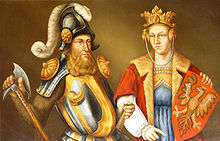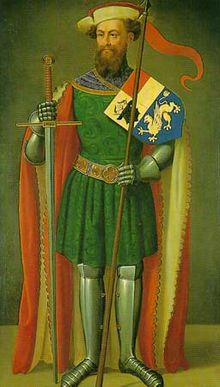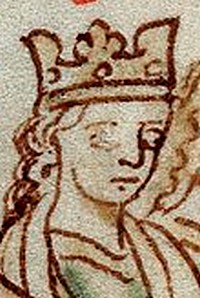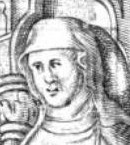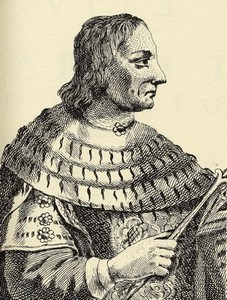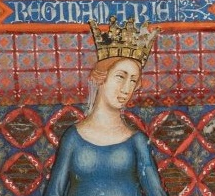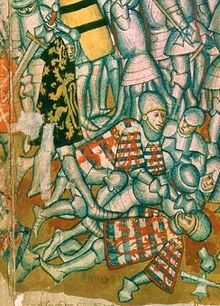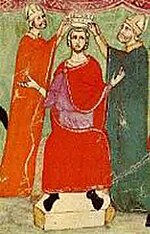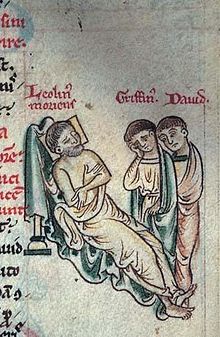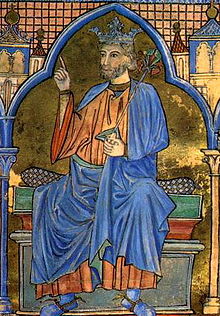|
|
Irmengard von Öttingen (d. 1399), daughter of Count Ludwig VI of Oettingen.
|
|
|
Marie de Luxembourg, daughter of John of Luxembourg, Count of Ligny, and Alix de Dampierre
Kraft II Von HOHENLOHE-WEIKERSHEIM
Adelheid Countess Of WHURTTEMBERG
: Ulrich I, Landgrave Of LEUCHTENBERG
Anna, Burgravine Of NURNBERG
Ulrich Iv, Count Of HANAU MUNZENBERG
Elisabeth, Countess Of WERTHEIM
Gottfried Viii, Count Of ZIEGENHAIN
Agnes, Princess Of BRUNSWICK
Friedrich II Count Of HOTTINGEN
Adelheid Countess Of WERD
Mikolaj, Prince Of MUNSTERBERG
Anezka KRUSINOVA
Father: Oldrich KRUSINA b: Abt 1302 in Lichtenberg, Varnsdorf, Czechoslovakia
Boleslaw, Prince Of KOSEL BEUTHEN
Marketa Ze STERNBERKA
Jeanne, Dame de Chateaudun ( c. 1227 – after 1252) was a French heiress and the wife of two French noblemen Jean I de Montfort, and Jean de Brienne, Grand Butler of France.
Jeanne was born in France in about the year 1227, the eldest daughter and co-heiress of Geoffrey VI, Viscount de Chateaudun (d. 6 February 1250 on Crusade), and his wife Clémence des Roches (died after September 1259). Her father also held the titles of seigneur of Chateaudun, Chateau-du-Loir, Mayet, Loupeland, Montdoubleau, and la Suze. [1] In 1229, he participated in the Crusade against the Albigenses in the Languedoc.
Matilda, also referred to as Mathilde or Mahaut, was born about 1230, the first child of Robert VII, Lord of the castle and town of Béthune and Advocate of the Abbey of St. Vaastat Arras, who was a major landowner and one of the twelve peers of Flanders. Her mother was Elizabeth, widow of Nicholas I, Lord of Condé, and daughter of Arnold IV, last Lord of Morialmé (fr). Robert and Elizabeth had two further daughters, Elizabeth and Sarah. [1]
Manasses V, Count of Rethel (died 1272) was the youngest son of Count Hugh II and his wife, Felicitas of Broyes.
Elisabeth of Écry
Elisabeth of Morialmez
Archambaud IX of Bourbon (died 15 January 1249), called " Le Jeune" ("The Young"), was a ruler (sire) of Bourbonnais in the modern region of Auvergne, France.
Hugh II, Count of Rethel (died 1227) was a son of Manasses IV and his wife, Matilda of Kyrburg. In 1199, he succeeded his father as Count of Rethel
Felicitas (d. 1257), the daughter of Simon of Broyes
- Born about 1210
- Deceased before 1256
Parents
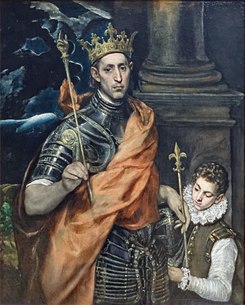
Adelaida de Borgoña era hija de la bávara Casa de Welf. Era hija de Conrado II de Borgoña (h. 835-876), conde de París, de Auxerre y marqués de la Borgoña Transjurana, 1 et de Waltrade de Wormsgau.
Era hermana de Rodolfo I de Borgoña (h. 860-912), 1 rey de Borgoña, y de su medio hermana, por su padre, de Adelgunda de Borgoña (872-902), casada, en 890, con Erenfredo I de Maasgau (866-904), conde de Bliesgau, de Keldachgau, de Bonngau, y de Charmois. 2
Hijo de Teobaldo I y hermano de Teobaldo II, se hace cargo del reino a la muerte de su hermano al morir éste sin sucesión.
Jun I de Brabante, llamado el Victorioso (c. 1251 - 1294), fue duque de Brabante desde 1267 y duque de Limburgo a partir de 1288 y hasta su muerte. Sucedió en el ducado a su hermano Enrique IV, quien renunció a la corona ducal al alcanzar la mayoría de edad. Fue hijo de Enrique III, duque de Brabante, y de Adelaida de Borgoña.
Era hija de Burkard V, conde de Hohenberg (m. 1253) y su esposa Mechtilde de Tubinga.
Burkard IV era hijo de Burkard III, conde de Hohenberg, quien era uno de los dos hijos de Burkard II, conde de Hohenberg. Gobernó junto con su hermano Federico, conde de Hohenberg. Su hermano no tenía descendientes conocidos y los dos hermanos, por lo tanto, tuvieron un solo sucesor. Burkard II fue uno de los cinco hijos conocidos de Federico I, conde de Zollern y su esposa Udahilda de Urach.
Inés de Borbón-Dampierre (?, 1237 – ?, 7 de septiembre de 1288), fue una noble francesa, señora de Borbón, desde 1262hasta su muerte. Ultimo miembro de la Casa de Borbón-Dampierre que gobernó el señorío.
Bolesław II the Rogatka or Bolesław II the Horned ( Polish: Bolesław II Rogatka, known also as Bolesław II the Bald, Polish: Bolesław II Łysy; ca. 1220/5 – 26/31 December 1278) was a Duke of Kraków briefly in 1241, of Southern Greater Poland during 1241–1247, and Duke of all Silesia– Wrocław 1241-1248, when it was divided between him and his brothers. He was Duke of Środa Śląska in Silesia from 1277 onward. The second Mongol raid against Poland, led by Nogai Khan, occurred during his reign.
Margrave Otto V of Brandenburg-Salzwedel (c. 1246 – 1298), nicknamed Otto the Tall, was a son of Margrave Otto III and co-ruler of Brandenburg with his cousin, Margrave Otto IV.
Judith of Henneberg-Coburg, a daughter of Count Herman I of Henneberg.

Isabel nació en 1240 como hija de un príncipe cumano de nombre desconocido (se estima que era Kuthen /Kötöny, el líder que arribó con su gente a Hungría en 1239 y que pactó numerosos acuerdos amistosos con el rey Bela I


|
|
Llywelyn the Great (Welsh: Llywelyn Fawr, [ɬəˈwɛlɨn vaur]), full name Llywelyn ap Iorwerth, (c. 1172 – 11 April 1240) was a Prince of Gwynedd in north Wales and eventually de facto ruler over most of Wales. By a combination of war and diplomacy he dominated Wales for 40 years Llywelyn was born about 1173, the son of Iorwerth ap Owain and the grandson of Owain Gwynedd, who had been ruler of Gwynedd until his death in 1170.

Fernando III de Castilla, llamado «el Santo» (Peleas de Arriba, 1199 o 24 de junio de 12011 -Sevilla, 30 de mayo de 1252), fuerey de Castilla entre 1217 y 1252 y de Leóna entre 1230 y 1252. Hijo de Berenguela, reina de Castilla, y de Alfonso IX, rey de León, unificó definitivamente durante su reinado las coronas castellana y leonesa, que habían permanecido divididas desde la época de Alfonso VII «el Emperador», quien a su muerte las repartió entre sus hijos, los infantes Sancho y Fernando.
Joan of Dammartin ( French: Jeanne de Dammartin; c. 1220 [1] – 16 March 1279) was Queen consort of Castile and León (1252), suo jure Countess of Ponthieu (1251–1279) and Aumale (1237–1279). Her daughter, the English queen Eleanor of Castile, was her successor in Ponthieu. Her son and co-ruler in Aumale, Ferdinand II, Count of Aumale, predeceased her, so she was succeeded by her grandson John I, Count of Aumale, deceased at the Battle of Courtrai, 11 July 1302.
Sir Roger La Zouche, Lord of Ashby, the son of Sir Alan La Zouche and Helen de Quincy
Ela Longespee, Lady of Ashby (1244 – c. 19 July 1276) was a wealthy heiress and daughter of Stephen Longespee, Justiciar of Ireland, and Emmeline de Riddlesford, granddaughter of Walter de Riddlesford. [1] She was the wife of Sir Roger La Zouche, Lord of Ashby.
Ela was born in 1244 at Salisbury, Wiltshire and was the eldest daughter and co-heiress of Stephen Longespee, Justiciar of Ireland, Seneschal of Gascony. Her paternal grandmother was Ela, Countess of Salisbury, who had founded Lacock Abbey, and for whom she was named. Her maternal grandmother was the daughter of Henry FitzRoy (d. 1158). Ela had a younger sister, Emmeline, who became the second wife of Maurice FitzGerald, 3rd Lord of Offaly in 1273.
William II de Fiennes, Baron of Tingry and Fiennes, son of Enguerrand II de Fiennes and Isabelle de Conde.
Blanche de Brienne, Baroness Tingry (c. 1252 – c. 1302) was the wife of William II de Fiennes, Baron of Tingry (c. 1250 – 11 July 1302). She was also known as Dame de La Loupeland, and Blanche of Acre.
Blanche was born in about the year 1252 in France. She was the only child and heiress of Jean de Brienne, Grand Butler of France, and his first wife, Jeanne, Dame de Chateaudun, widow of Jean I de Montfort. Her paternal grandparents were John of Brienne,King of Jerusalem, Emperor of Constantinople, and Berenguela of Leon, and her maternal grandparents were Geoffrey VI, Viscount de Chateaudun and Clémence des Roches. Blanche had a uterine half-sister Beatrice de Montfort, Countess of Montfort-l'Amauryfrom her mother's first marriage to Jean I de Montfort (died 1249 in Cyprus). In 1260, Beatrice married Robert IV of Dreux, Count of Dreux, by whom she had six children.
John FitzAlan, 7th Earl of Arundel (14 September 1246 – 18 March 1272) was an English nobleman. He was also feudal Lord of Clun and Oswestry in the Welsh Marches.
]Isabella Mortimer, Lady of Clun and Oswestry (born after 1247; died before 1 April 1292[1]) was a noblewoman and a member of an important and powerful Welsh Marcher family. Although often overshadowed in modern historiography by her better-known parents, she is now known to have played an important part in her family's struggles against Llywelyn ap Gruffudd and to have helped to secure the frontline at Shropshire in the run-up to English conquest of Wales. She was the wife and widow of John III FitzAlan, baron of Clun and Oswestry and de jure earl of Arundel. After a lengthy widowhood, she married for a second time and largely disappeared from the records.
Isabella was born some time after 1247, possibly at Wigmore Castle, Herefordshire, the daughter of Roger Mortimer, 1st Baron Mortimer and Maud de Braose. Her father was a celebrated soldier and Marcher baron; and her mother was a staunch royalist during the Second Barons' War who devised the plan for the escape of Prince Edward, the future King Edward I of England, from the custody of Simon de Montfort, 6th Earl of Leicester. She had one sister and five brothers, including Ralph, would-be heir to the family estates, who predeceased his parents, and Edmund Mortimer, 2nd Baron Mortimer.
Luisa of Ceva.died 22 August 1291/1293), daughter of Giorgio, Marquis of Ceva[2] and Menzia d'Este.
Alice de Sanford, daughter and heiress of Gilbert de Sanford
Robert I (25 September 1216 – 8 February 1250), called the Good, was the first Count of Artois, the fifth (and second surviving) son of Louis VIII of France and Blanche of Castile.[
 Matilda of Brabant (14 June 1224 – 29 September 1288) was the eldest daughter of Henry II, Duke of Brabant and his first wifeMarie of Hohenstaufen.
Matilda of Brabant (14 June 1224 – 29 September 1288) was the eldest daughter of Henry II, Duke of Brabant and his first wifeMarie of Hohenstaufen.

William de Beauchamp, 9th Earl of Warwick (1237–1298) was an English nobleman and soldier, described as a “vigorous and innovative military commander”.[1] He was active in the field against the Welsh for many years, and at the end of his life campaigned against the Scots. His father was William de Beauchamp (d.1268) of Elmley Castle and his mother Isabel Mauduit, sister and heiress of William Mauduit, 8th Earl of Warwick
Maud FitzJohn, Countess of Warwick (c. 1238 – 16/18 April 1301) was an English noblewoman and the eldest daughter of John FitzGeoffrey, Lord of Shere. Her second husband was William de Beauchamp, 9th Earl of Warwick, a celebrated soldier. Through her daughter, Isabella, Maud was the maternal grandmother of Hugh the younger Despenser, the unpopular favourite of King Edward II of England, who was executed in 1326. Maud was born in Shere, Surrey, England in about 1238, the eldest daughter of John FitzGeoffrey, Lord of Shere, Justiciar of Ireland, and Isabel Bigod, a descendant of Strongbow and Aoife of Leinster.
Albert II of Gorizia (German: Albrecht II., Graf von Görz) was a son of Count Albert I of Gorizia and his wife, Euphemia of Silesia-Glogau.
Elisabeth, a daughter of Landgrave Henry I of Hesse and, secondly, Euphemia of Mätsch, daughter of bailiff Ulrich II.
Count Ulrich V of Pfannberg (1287 – 23 October 1354) was Count of Pfannberg. From 1322 to 1337, he was governor of Gornji Grad and from 1330 Marshal of the Duchy of Austria. From 1330 to 1335, he was also governor of Carinthia.
He was the son of Count Ulrich IV and Margaret of Heunburg.
Margaret, the daughter of Count Hugh II of Werdenberg and Euphemia of Ortenburg.
|
Sophia of Brandenburg-Stendal (1300-1356) was a daughter of Margrave Henry I (1256–1318) and his wife Agnes of Bavaria(1276–1345).
Bernhard III, Prince of Anhalt-Bernburg (died 20 August 1348) was a German prince of the House of Ascania and ruler of the principality of Anhalt-Bernburg.
Albert (Latin Albertus; c. 1268 – 22 September 1318), called the Fat ( pinguis), was duke of Brunswick-Lüneburg.
Henry II of Hesse (German: Heinrich), (c. 1299 – 3 June 1376) called "the Iron" was Landgrave of Hesse from 1328 - 1376.
He was the son and heir of Count Eberhard II and his wife, Irmgard of Berg
Mechtilde ofArenberg (died March 18, 1328), daughter of Johann of Arenberg and Katharina of Jülich.
Dietrich VIII ( c. 1291 – 7 July 1347) was a German nobleman. He was Count of Cleves from 1310 through 1347.
William V, Duke of Jülich ( c. 1299 – 25/26 February 1361) was a German nobleman. Some authors call him William I, because he was the first Duke of Jülich; the earlier Williams had been Count of Jülich. Other authors call the subject of this article "William VI"; they count the son and co-ruler of William IV as William V.
Otto IV, Count of Ravensberg ( c. 1276 – 1328) was a German nobleman. He was the ruling Count of Ravensberg from 1306 until his death.
Margaret of Berg-Windeck ( c. 1275/1280 – between 1339 and 1346) was a German noblewoman.
She was the only daughter of Henry of Berg, Lord of Windeck and his wife Agnes of the Marck.
Ludwik I the Fair or Louis I the Fair also known as the Wise, the Right or of Brzeg (Brieg) ( Polish: Ludwik I Sprawiedliwy,Roztropny, Prawy or brzeski; c. 1321 – 6 /23 December 1398), was a Duke of Legnica two times: first during 1342–1345 (with his brother) and secondly during 1345–1346 (alone), and Duke of Brzeg from 1358. Also, he was regent of Legnica during 1364–1373.
|
Henry I of Montfaucon (before 1318–1367) Gauthier II, seigneur de Montfauçon yMahaut de Mailly, dame de Chaussin
Agnes, the daughter of Reginald of Burgundy,
His mother Béatrice de La Tour-du-Pin (1275–1347) was the daughter of the comte Humbert I.
William V, Duke of Jülich ( c. 1299 – 25/26 February 1361) was a German nobleman. Some authors call him William I, because he was the first Duke of Jülich; the earlier Williams had been Count of Jülich. Other authors call the subject of this article "William VI"; they count the son and co-ruler of William IV as William V.
Nicholas I of Tecklenburg (also known as Nicholas I of Schwerin; died: 1367) was a son of Gunzelin VI, Count of Schwerin and Richardis, the daughter of Count Otto IV of Tecklenburg.
Helena, the daughter of Count Otto of Oldenburg-Wildeshausen-Altbruchhausen
Bernhard V, Lord of Lippe ( c. 1290 – before 1365) was a member of the House of Lippe and was Lord of Rheda from 1344 until his death.
Richarda of the Marck.
|
|
|
|
|
|
|
